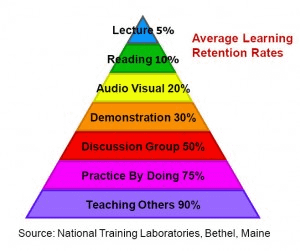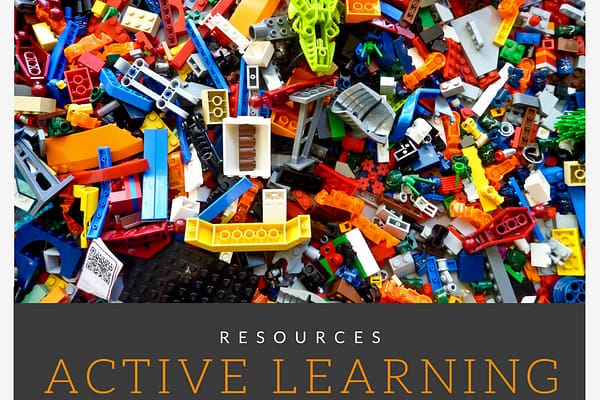I just finished listening to a Teaching in Higher Ed podcast episode with Mike Caulfield on digital literacy that will air on Thursday, February 2.
Not to give too much away, but at the end of the conversation, we chat about the tooth fairy, and other childhood myths. I joke about how I have tended to stay away from controversial topics on the podcast, but that I couldn't resist sharing that my husband and I don't plan on telling our children that there is such a thing as the tooth fairy.
Since I have started down the path of breaking out of my “safe” topics pattern here on Teaching on Higher Ed, I thought I would share two myths about learning that are almost always cause for concern by people who have subscribed to them throughout their career as educators.
We all have one primary learning style that needs to be accommodated for in our learning
I bought into this myth for at least the first ten years of my corporate training career. Now, I'm confident that believing in this myth actually makes our teaching worse.
- All You Need to Know About the ‘Learning Styles’ Myth, in Two Minutes
- Letting Go of Learning Styles
- Stop propagating the learning styles myth
- One Reason the ‘Learning Styles’ Myth Persists
- The Myth of Learning Styles
One take-away from the research that debunks this myth is to have multiple approaches for helping learners comprehend what you're trying to teach, instead of gearing the students' experiences toward their preferred learning experience. Consider ways of making your teaching visual, auditory, and kinesthetic, using more than one approach at a time.
I once posted about the learning styles myth on my personal Facebook page, having no idea the topic is as controversial as it seems to be… Please refrain from thinking that showing this myth for what it is (unsubstantiated) does not mean that people don't have learning disabilities. That's an entirely different domain. Yes, dyslexia exists, for example… and there are ways in which we, as educators, should be accommodating for that disability.
If we have learners “practice by doing,” they will retain 75% of what they're “taught”
 This learning pyramid has also been propagated across multiple educational contexts. It is meant to encourage us to move up as high as we can on the pyramid, lest we leave people only remembering 5% of what we said. This is not to say that there isn't ample research to illustrate the effectiveness of active learning pedagogical approaches, but doesn't the “tidiness” of these numbers make you a bit suspicious?
This learning pyramid has also been propagated across multiple educational contexts. It is meant to encourage us to move up as high as we can on the pyramid, lest we leave people only remembering 5% of what we said. This is not to say that there isn't ample research to illustrate the effectiveness of active learning pedagogical approaches, but doesn't the “tidiness” of these numbers make you a bit suspicious?
- Tales of the Undead…Learning Theories: The Learning Pyramid
- Why the ‘learning pyramid’ is wrong
- The diffusion of the learning pyramid myths in academia: an exploratory study
- Five common but inexcusable learning myths about how we learn
Active learning can help motivate students and help them retain more information. However, the process of learning (and teaching) is far more complex than a diagram like this could ever convey.
Your Turn
What teaching and learning myths have you observed that have persisted for too long now?


Great topic! One myth I’d like to see go extinct is the idea that when you learn a lot about a particular field, you are automatically able to teach it.
I’ve been in classes with instructors and professors who obviously knew SO MUCH about their subject and LOVED talking about it. However, they were barely able to teach it clearly to students who had very little knowledge about it and were only there because it was a required class.
Teaching is a field just like every other field. If you don’t study effective teaching, you won’t be magically granted that skill just because you know a lot about some other field.
No one is born knowing how to teach. Even teachers need teachers to teach them how to teach!
Thanks, Jason. What you brought up would have made for a perfect third myth to go with this post.
Bonni
I often look at some of my colleagues and what they say about learning and what that looks like. I hear the words active learning which looks like busy work, and I hear the words rigor meaning an increase in assignments. For me these are two myths that need to be looked at. The process of teaching has a lot to do with the teachers perspective and what they bring to the classroom. In terms of identifying learning styles during our first class I ask students how do they feel they learn best. This begins a conversation that makes them comfortable, simply because someone is taking the time to ask. In all my classes I use a multi model approach where the students experience all the possibilities to learn material. Lecturing alone gives some colleagues the illusion of control and diminishes active discussion. This is especially true when it’s just reading power points and the instructor limits discussion because they have to finish the power points for that particular class. In terms of rigor, adding more work can frustrate students especially if they are older students. On top of all their other responsibilities adding more work does not guarantee knowledge retention or appreciation.
I encourage students to participate and discuss even if I do not finish the lecture, because for me it is more important that they engage and appreciate the information that they are receiving. There are so many ways to get the information to students and it all does not have to be in one class. Lively discussions turn on the students creative juices and then they realize that they have something to contribute. I use a method of story telling or anecdotal information to spark conversations and to make it real. Unfortunately relying on text material can sometimes overshadow what students will be receiving in the real world. Our teaching and content knowledge has to expansive not restrictive.